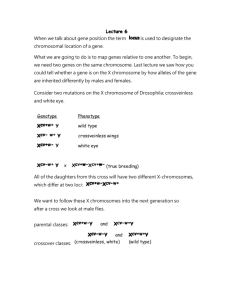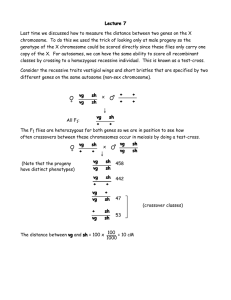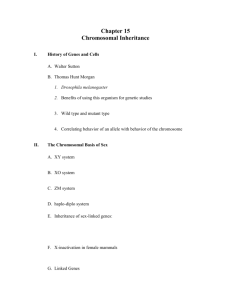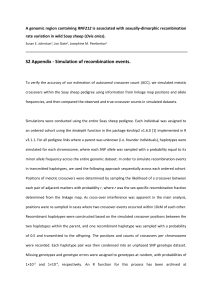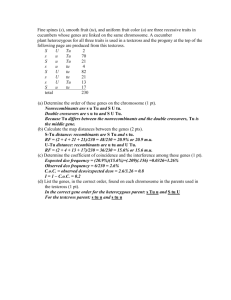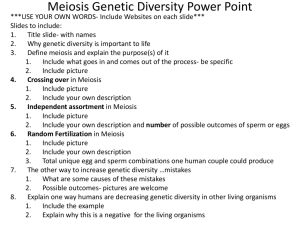Lecture 6 locus location of a gene.
advertisement
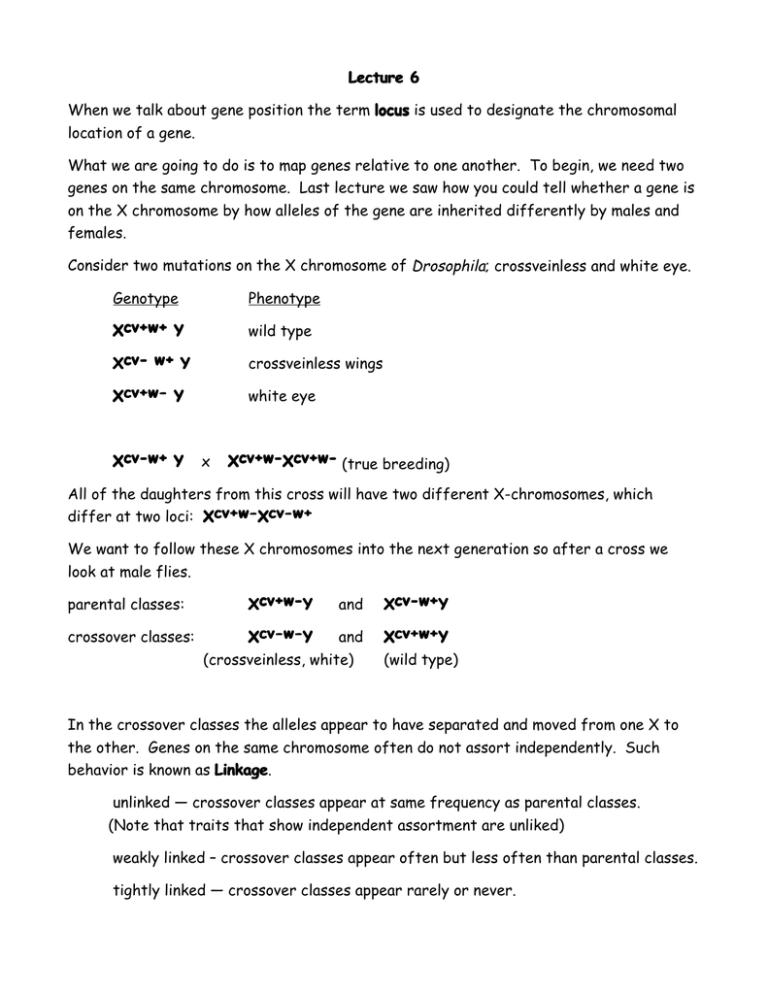
Lecture 6 6 When we talk about gene position the term locus is used to designate the chromosomal location of a gene. What we are going to do is to map genes relative to one another. To begin, we need two genes on the same chromosome. Last lecture we saw how you could tell whether a gene is on the X chromosome by how alleles of the gene are inherited differently by males and females. Consider two mutations on the X chromosome of Drosophila; crossveinless and white eye. Genotype Phenotype Xcv+w+ Y wild type Xcv- w+ Y crossveinless wings Xcv+w- Y white eye Xcv-w+ Y x Xcv+w-Xcv+w- (true breeding) All of the daughters from this cross will have two different X-chromosomes, which differ at two loci: Xcv+w-Xcv-w+ We want to follow these X chromosomes into the next generation so after a cross we look at male flies. parental classes: crossover classes: Xcv+w-Y and Xcv-w-Y and (crossveinless, white) Xcv-w+Y Xcv+w+Y (wild type) In the crossover classes the alleles appear to have separated and moved from one X to the other. Genes on the same chromosome often do not assort independently. Such Linkage. behavior is known as Linkage unlinked — crossover classes appear at same frequency as parental classes. (Note that traits that show independent assortment are unliked) weakly linked – crossover classes appear often but less often than parental classes. tightly linked — crossover classes appear rarely or never. To see what’s really going on we need to look at the chromatids in prophase of meiosis in the mother. Crossovers between homologous chromosomes occur more or less at random during meiosis. To give you a rough idea of how frequent these crossovers are, in several different well studied organisms (Yeast, Drosophila, and humans) there is about one crossover per chromosome arm per meiosis. The geneticist uses these random crossovers as a tool to measure distance. Distance can be obtained because crossovers between two points that are close together will rarely occur whereas crossovers between points that are far apart will occur frequently. Definition of genetic distance: map distance (m.u. or cM) = 100 x O cv- W+ CV+ w- x crossover gametes total gametes (Note new notation) O (In order to detect both dominant and recessive alleles, we look at males only) cv- W+ 430 CV+ w- 450 cv- w- 52 CV+ W+ 68 Number of crossover gametes = 120 Distance = 100 x 120 1,000 Total gametes = 1,000 = 12 cM It is important to note that once a map distance between two genetic markers has been established this distance can be used to calculate the expected numbers of each type of progeny. For example, if you know that two mutations are 12 cM apart then you should expect that 6% of the progeny from a cross will be of each of recombinant class. Things get interesting when we make several pairwise crosses between genes on the same chromosome. We can use this data to construct a Genetic Map Genetic maps have the following properties: i) Distance is proportional to frequency of crossover classes (this approximation actually only holds for short distances of <20 cM) ii) Distances are approximately additive: mapped points fall on a line. iii) Maps are internally consistent and concise. (The first genetic map was constructed in 1911 by Alfred Sturtevant when he was a sophomore student in Morgan’s lab) It is important to remember that genetic distances are measured using a property of meiosis (genetic recombination) that varies from one organism to another. The relationship between genetic distance and actual physical distance can be summarized in this way: Genetic distance = physical distance x recombination rate The actual relationship between genetic distance in cM and physical distance in base pairs (bp) depends on the recombination rate and is different for different organisms For example: Human: 1.3 cM/Mbp Yeast: 360 cM/Mbp Sometimes recombination rates in the male and female of a species are different. In Drosophila there is no recombination in the male so the genetic distance between markers on the same chromosome are always zero when examined by meiosis in the male. In humans the recombination rate (and therefore map distances) in the female are twice that of the male. Another issue that often causes confusion concerns the map distances of genes that are far apart on the same chromosome. The physical length of a genetic interval is proportional to the frequency of crossovers that occur in that interval during meiosis but in a cross we are not actually counting crossovers rather we are counting the number of recombinant progeny that are produced. The number of recombinants provide a good approximation of distance for short intervals but as the interval length increases, multiple crossovers are possible making the relationship between frequency of recombinants and crossovers not linear. Crossovers between same chromatids Recombinant progeny 1 yes 2 no 3 yes 4 no If the measured distance in a cross is statistically indistinguishable from 50 cM then we say that the genes are unlinked. But this doesn’t mean that distances greater than 50 cM can not be obtained. By adding intervals, longer distances that are meaningful can be obtained. For example, if all the intervals between linked genes in the human genome are added together the total length of the genome (in males) is 2,500 cM.
